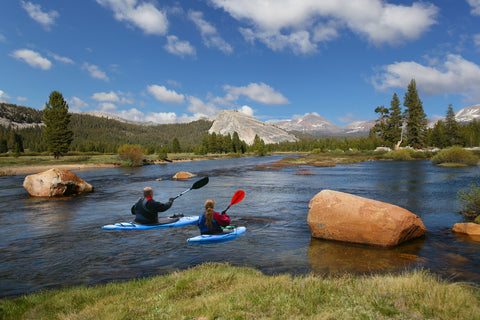Where is Yosemite National Park
Tucked away in the rugged Sierra Nevada Mountains, in eastern central California, you’ll find Yosemite National Park. Yosemite is about an hour from the Nevada state line. The park is only a little more than an hour north of Fresno and 3 hours east of San Francisco. Yosemite is nestled between two national forests; Stanislaus National Forest to the north and Sierra National Forest to the south. The park is world renowned for its iconic scenery, including giant sequoia trees, breathtaking geological features, and splendid waterfalls.

How Big is Yosemite National Park
Yosemite is mighty! The park covers roughly 1,169 square miles, which is about the size of Rhode Island. It stretches across four counties. The US National Park is home to thousands of lakes and ponds, 1,600 miles of streams, and 800 miles of hiking trails. The highest point in Yosemite is Mount Lyell. Mount Lyell peaks at 13,114 feet and is the home of the Lyell Glacier. The lowest point of the park is along the Merced River, which rests at 2,105 feet.
Yosemite National Park Weather
The weather at Yosemite can vary dramatically between the seasons and different elevations. Sierra winters are cold, wet and snowy. Around 70% of the yearly precipitation at the park falls between November and March. It is usually snow, especially in the foothills and mountains above Yosemite Valley. Rain and melting snow cause waterways to fill or overflow, leading to limited backpacking opportunities through May and early June. The temperature ranges from freezing at night to the mid-70s during the day.
Summer is the most popular time to visit Yosemite. The days are warm and dry, with an occasional thunderstorm. Depending on where you are in the park, temps during the day are between 70-100°F, with temps dipping into the night as low as 30°F. Fall features warm days and cool nights, with temperatures dropping as the season advances. The rich colors of autumn are quite a splendid spectacle, making this another popular season for Yosemite.
When did Yosemite become a National Park
Yosemite officially became a national park on October 1, 1890. Yosemite might be the country’s 3rd national park, but it actually inspired the idea of national parks. On June 30, 1864, President Abraham Lincoln signed the Yosemite Land Grant, which safeguarded Yosemite Valley and Mariposa Grove. It was the first case of the government protecting land for the preservation of natural beauty for the people.

Things to do in Yosemite National Park
There is a little something for everyone in Yosemite. Our National Park Visitors Guide covers some of the most popular activities in Yosemite as well as the best times to enjoy them.
Yosemite Valley Waterfalls
There are more than 2 dozen waterfalls in Yosemite. They vary in location, size and volume, but they all offer stunning trails and magnificent views. Some of the most popular falls include Sentinel Fall, Wapama Falls, Horsetail Fall, and Yosemite Falls (the park’s tallest waterfall).
Giant Sequoias
Yosemite is home to three giant sequoia groves. These groves feature ancient towering trees that dwarf all things around them. The most visited sequoia spot is Mariposa Grove. Mariposa Grove is easily accessible spring through fall. The Tuolumne and Merced Groves are near Crane Flat.
Rock Climbing
This park is world famous for rock climbing. There are some of the tallest and most challenging climbs in the country. Choose from more than a dozen climbs like Royal Arches, Salathe Wall and Munginella. The most iconic climb in the park is Half Dome.
Glacier Point
Glacier point offers one of the best views in the park. It overlooks Yosemite Valley, Yosemite Falls and Half Dome. The point is accessible from late May until November via car. December through March, cross-country skiers can reach Glacier Point after skiing 10.5 miles.
Crane Flat
Crane Flat is a gorgeous meadow and forest. It features footpaths to both the Tuolumne and Merced Groves of Giant Sequoias. In the winter time, enjoy sledding down the rolling hills at the Snow Play Area. There’s also a spacious campground with over 160 campsites.
Wawona Campground
The campground at Wawona is pleasant and tranquil. It is central to Yosemite’s historical structures, including the headquarters from 1904. The campground is near the largest sequoia grove in the park, Mariposa Grove. It’s also close to Chilnualna Falls and trail, which flows all year.

Animals in Yosemite
Yosemite is home to more than 400 different species of animals. There’s a good chance you’ll encounter some wildlife on your visit. Living in the park are animals like black bears, bobcats, coyotes, bighorn sheep, mule deer, a myriad of birds, and so many more!
Half Dome
Yosemite is known for the Half Dome. It is a gorgeous and unique geological feature that also offers visitors hiking opportunities. The hike is a 14-16 mile trek with views of Nevada Falls, Liberty Cap, Yosemite Valley and more. You will need a hiking permit.
Tunnel View
Visitors have been enjoying the stunning sights from Tunnel View since 1933. Made famous by Ansel Adams, the vista offers views of El Capitan, Half Dome, and Bridalveil Fall. No hiking required, just park at the overview lots near Wawona Tunnel on State Highway 41.
Hiking Trails
Yosemite has over 120 hiking trails adding up to over 800 miles. There are day hikes and backpacking trips. Trails range from easy to challenging. There’s a trail and a view for everyone. Remember to stay on the trails to preserve them and the park!

When to go to Yosemite National Park
All the seasons have something unique to offer the guests of Yosemite. The time you go is completely up to you and depends on what you want to do while you are there. May and September are the most accessible months with the smallest crowds. Note that winter snow shuts down many roads and trails in the park. However, winter is the only time the Yosemite Ski Area is open. It’s also the only time to witness the stunning Natural Firefall at Horsetail Fall, which happens around the second week of February. If you want to see the park’s waterfalls at their peak, May and June are your best bet. Hiking or backpacking excursions are excellent in July and August.
Must-Have things to bring to Yosemite
When you’re out on adventure in Yosemite National Park, there are a few items List of Parks suggests to bring. Having the right gear will help ensure you have a good trip.
Water
Whether you bring bottles or a hydration filtration system, you’ll want water on your excursion around the park. There are no fountains on the trails. Water from streams and creeks must be treated first. Save yourself from dehydration and come prepared with plenty of water.
Food/Snacks
After water, you’ll need to keep your energy up too. Many trails are quite difficult. You’ll want recovery fuel along the way or after. Snacks like trail mix, jerky, veggies, and fruit are excellent choices. Store any food you have in bear lockers at night.
Park Maps in physical and on phone
Yosemite National Park covers hundreds of miles over winding trails and vast swaths of wilderness. You’ll want a map of the park so you don’t get lost. Phone maps are excellent for giving directions, but you will also want a physical copy as a backup.

A Rain Jacket
You might think California is just dry, but there are frequent thunderstorms in Yosemite, especially in summer. After the rain, the temperature will drop. You’ll want a jacket that can keep you warm and dry. Opt for a waterproof or watertight jacket, not water resistant.
Proper Hiking Boots
The domes and peaks around Yosemite are made of hardy granite, which can be rough on hikers. Granite is tough, making it difficult to maneuver and hard on feet. Pack a pair of boots that are waterproof, hard-soled, and breathable for the best hiking experience.
Sturdy Water Shoes
Yosemite is a water playground. Splash in the creeks and streams. Do some kayaking or canoeing. Flip flops are easy to lose or break. If you’re getting in the water, you’ll want sturdy water shoes to protect your feet from river rocks and stray logs.
Warm and Cold Clothing Layers
The temperature at the park varies greatly depending on the weather, elevation and season. It is not unreasonable for a 30 degree temperature fluctuation during the day. Bring several light layers so you can remove clothes when you’re hot and add them when you’re cold.

Binoculars
The park is home to roughly 500 bears as well as other large and elusive wildlife. Having binoculars will give you a better chance of seeing these creatures. You can also take a good look at the rock climbers on Half Dome and El Capitan.
Sun Hat, Sunglasses and Sunscreen
Yosemite rests on average at an elevation of 4,000 feet, which means the sun is closer, hotter and more powerful. You’ll want to protect yourself from heat and harmful sun rays. Sunglasses and a wide brimmed hat are recommended. Sunscreen is definitely a must.
Star Chart or Star App
Yosemite is a vast wilderness with dark nights. Urban skies might have 500 visible stars while the park boasts 15,000, which makes for prime stargazing opportunities. Glacier and Olmsted Points offer the best views. A Star Chart will help you find formations and constellations.
Bug Spray
You’ll find that there are plenty of small pests thriving in the wild of Yosemite. The best way to avoid encounters with insects like flies, mosquitos, and ticks is to bring along bug spray. Many park stores offer bug spray and other deterrents for purchase.

Where to stay in Yosemite National Park
You’ve got plenty of options when it comes to finding a place in Yosemite to lay your head down for the night. If you want to sleep in style and luxury, check out the Ahwahnee Hotel. The Wawona Hotel is close to the sequoia groves. There are several campsites that feature traditional and canvas-sided tent cabins, including White Wolf Lodge and Curry Village. Glacier Point Ski Hut is only accessible via a cross-country ski trip.
Food Nearby Yosemite
You don’t have to plan and pack every meal for your Yosemite trip, there’s ample dining around the park. There are several grills and bars throughout the area. Denigan’s features a bakery and a loft restaurant. Grab groceries at the Village Store or Starbucks at Base Camp Eatery. There’s even fine dining available at the Mountain Room and Ahwahnee Hotel.
Airports near Yosemite National Park
There are plenty of flights to get you in and out of the area. Merced Airport is only 2 hours from Yosemite Valley. Mammoth Yosemite and Stockton Metropolitan Airports are just a little further. There are also international airline hubs to choose from, including Fresno-Yosemite, Oakland, and Sacramento. Most airlines can be reached by Greyhound, Amtrak or YARTS year round.

